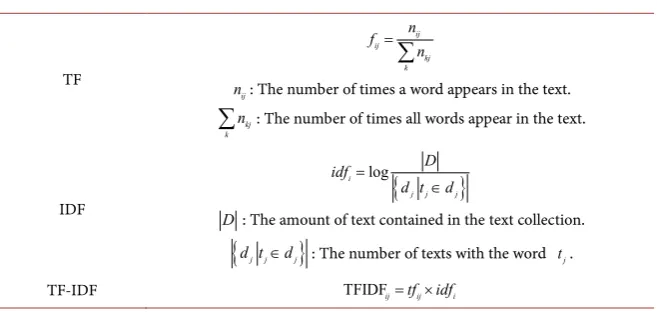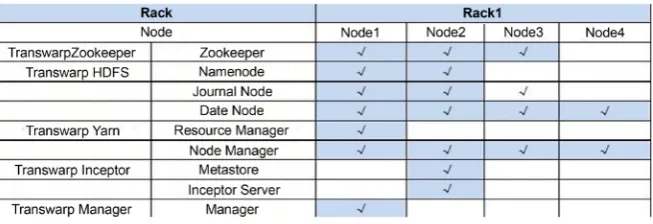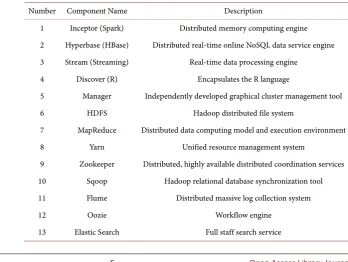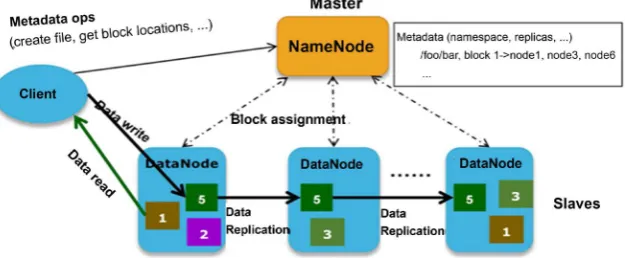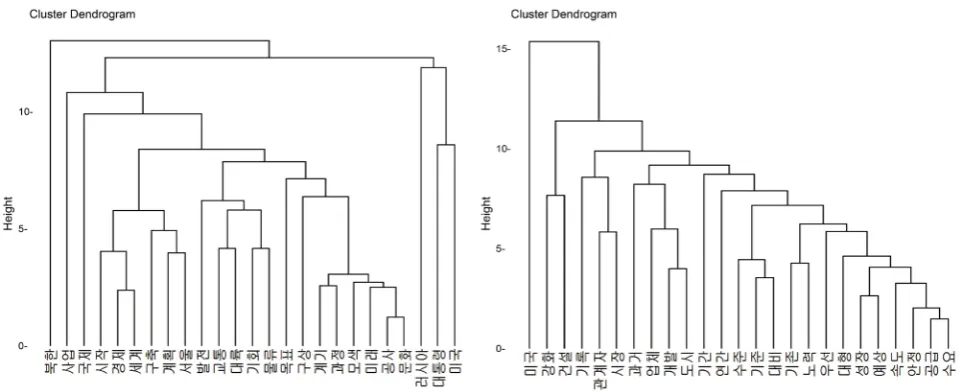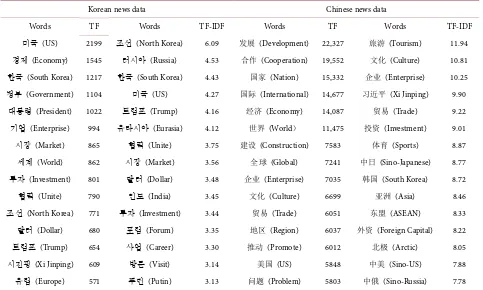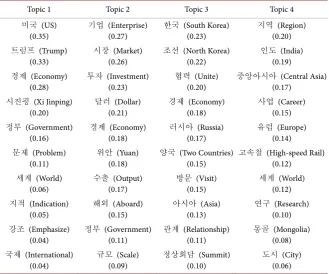ISSN Online: 2333-9721 ISSN Print: 2333-9705
DOI: 10.4236/oalib.1105742 Sep. 16, 2019 1 Open Access Library Journal
Related Research on “The Belt and
Road” Initiative Based on Big Data
Text Mining: Taking the Domestic
Area and the Korean Peninsula
as an Example
Hongyi Li
1, Zhezhi Jin
2*1Department of Mathematics, Yanbian University, Yanji, China
2Department of Economics and Management, Yanbian University, Yanji, China
Abstract
As one of the core contents of China, “The Belt and Road” is very necessary to analyze the impact and significance of “The Belt and Road” on the domes-tic areas and Korean Peninsula areas in the context of big data. The text min-ing method was used to extract the core content and hot topics from the news reports of “The Belt and Road” in China and the Korean Peninsula in recent domestic and international news data. Using the unique attributes of public opinion media and news reports. Focusing on the key theme of “The Belt and Road”, using clustering algorithm and TF-IDF method, combined with LDA topic model, the structure and content of the theme are analyzed in detail on the pre-built big data analysis platform. The establishment of a big data plat-form and the use of TF-IDF and LDA topic models have improved the effi-ciency of data analysis. On the domestic front, the eastward extension of “The Belt and Road” is imperative and the prospects are clearer. On the Korean Peninsula, its own security situation is the core issue, and the United States is the biggest drag factor. In the future, it is necessary to focus on the common focus and solve the problem.
Subject Areas
StatisticsKeywords
The Belt and Road, Text Clustering, TF-IDF, LDA Topic Model How to cite this paper: Li, H.Y. and Jin,
Z.Z. (2019) Related Research on “The Belt and Road” Initiative Based on Big Data Text Mining: Taking the Domestic Area and the Korean Peninsula as an Example. Open Access Library Journal, 6: e5742.
https://doi.org/10.4236/oalib.1105742
Received: August 29, 2019 Accepted: September 13, 2019 Published: September 16, 2019
Copyright © 2019 by author(s) and Open Access Library Inc.
This work is licensed under the Creative Commons Attribution International License (CC BY 4.0).
http://creativecommons.org/licenses/by/4.0/
DOI: 10.4236/oalib.1105742 2 Open Access Library Journal
1. Introduction
Since “The Belt and Road” was introduced in 2013, it has been regarded as the focus of attention and research in the whole society and even in the world. The analysis of the influencing factors is also one of the research hotspots. “The Belt and Road” is not just an initiative and policy, it is a trend. Since September and October 2013, Chinese President Xi Jinping officially proposed the cooperation initiative for the construction of “The New Silk Road Economic Belt” and “The 21st Century Maritime Silk Road”, and after the official release of “The Vision and proposed actions outlined on jointly building Silk Road Economic Belt and 21st-Century Maritime Silk Road” on March 28, 2015. Leading export index of foreign trade, maritime silk road trade index, and “The Belt and Road” aviation trade index all showed steady growth. At present, a large number of scholars have studied the related content of “The Belt and Road”. For example, Changxiu Hu, Jinglei Lin and others [1] have studied the situation of “The Belt and Road” in regional economic development. Li Wang [2] has studied the path of streng-thening the “The Belt and Road” foreign cultural communication, while Yumiao Lv and Hongchun Wang and others [3]. The application of big data in logistics management under the background of “The Belt and Road” has been studied. However, there are relatively few research literatures on foreign countries, such as the Korean Peninsula, which is closer to China and more closely related to it. Because of the difficulty in obtaining data, language inconsistency, and inability to accurately analyze foreign language data, the relevant research content is very less, but it is essential. Accurately analyzing the development and changes of the influence factors and influencing factors of “The Belt and Road” on the Korean Peninsula and other regions not only provides a scientific basis for the targeted strengthening of the relationship and development between the two parties, but also gives the implementation of the “The Belt and Road” policy. This paper makes use of the text mining method [4] [5], and based on a large amount of news data suitable for time series analysis, clusters [6] [7] [8] [9] [10] the data objects on the big data analysis platform. By finding the TF-IDF value of each word, the correlation and importance of each topic in each text are analyzed and compared. Using the topic model approach, combined with the LDA topic
mod-el [11], to more accurately screen the specified topics in each text data, and to
derive the changes in the factors affecting countries since “The Belt and Road” initiative, and provide the valuable reference for the subsequent development.
2. Research Steps and Related Theories
specif-DOI: 10.4236/oalib.1105742 3 Open Access Library Journal ically applied to text analysis, recently also used in the study of Korean language. The first step is to collect data. So far, there is no automated method for data collection. A large part of the data needs to be searched and collected by human means. This analysis uses the data reported by People’s Daily in China, and the data on the Korean Peninsula is the use of RodongSinmun and the news of ChosunIlbo, totaling nearly 100,000. News reports with “The Belt and Road” from 2015 to 2019 were adopted, and news reports containing “North Korea”, “South Korea”, “Korean peninsula” and other words were selected as specific analysis objects.
The second step is the stage of data cleansing. The process of transforming human natural language into a computer-understandable language is called nat-ural language processing, referred to as NLP. Data cleansing is the process of converting collected text data into natural language processing (NLP) and transforming it into a form that is easy to analyze, which needs to be done through data preprocessing and morphological analysis. In the process of data preprocessing, it is necessary to repeatedly remove unnecessary words and sen-tences from the collected text data, and unify the words that are similar or iden-tical but have different expression meanings. Then you need to remove stop-words that are not meaningful for analysis, such as special symbols, punctuation, numbers, onomatopoeia. The process of data pre-processing may be repeated, and the scope of its work will produce some differences depending on the ana-lyst. After the pre-processing work, the text of the essay text needs to use the KoNLP analysis package and classify according to the shape. By extracting the stem of the word, removing the affix and other stem extraction work, the unit form with the smallest meaning is separated, and the word class paste work is performed.
The third step is to analyze and visualize the data. First of all, in order to grasp the attention of countries on “The Belt and Road”, analyze the number of news reports on “The Belt and Road” first report, and then understand the similari-ties, core words and topics between the documents. In order to grasp the change of news data and whether there is similarity in each level, the analysis of text clustering by using the similarity between texts is used, which is a method of clustering and distinguishing similar words in text by text clustering algorithm. Multivariate data for cluster analysis does not require additional reaction va-riables, but only needs to be clustered based on similarity between individuals.
Secondly, we need to find the TF-IDF value to analyze the core words in the text data. Through Term Frequency (TF), according to the frequency of occur-rence of specific words in the text, you can grasp the importance of the word. However, the TF value alone cannot grasp the keywords in the text, so it is ne-cessary to use TF-Inverse Document Frequency (TF-IDF) value to calculate the frequency based on the probability of occurrence.
DOI: 10.4236/oalib.1105742 4 Open Access Library Journal Table 1. TF·IDF·TF-IDF output formula.
TF
ij ij
kj k
n f
n =
∑
ij
n : The number of times a word appears in the text.
kj k
n
∑
: The number of times all words appear in the text.IDF
{
}
log i
j j j
D idf
d t d =
∈
D: The amount of text contained in the text collection.
{
d t dj j∈ j}
: The number of texts with the word tj. TF-IDF TFIDFij=tf idfij× iwhich calculates the occurrence probability of words instead of occurrence quency, is used to evaluate the importance of designated words. And the fre-quency analysis of the topic words is effective for confirming the appearance of the topic. But it is difficult to grasp the unexpressed subject content only by the presence or absence of words. In order to accurately grasp the theme of each cluster about “The Belt and Road” related content, you need to use the Topic Modeling method. The topic model approach refers to the method of automati-cally extracting specific topics and combinations based on the frequency and usage of the topic words used in the collection of text. This time, the LDA topic model approach is used. The LDA method [12] is to calculate the appearance probability of each word w constituting the text M, and to judge the composition of the theme, and to connect the individual words and the theme, and then re-combine the words together.
The LDA method is composed of various unknown themes in individual texts, and is based on the premise that different words are represented and processed for most topics, and the potential causes of the constituent texts are analogized, and the complex data is reduced and simplified. LDA methods have some simi-larities with exploratory factor analysis in terms of effective understanding. Compared to other topic model methods, the results of the LDA topic model approach are easier to interpret and can solve overfitting problems. Therefore, it is beneficial to derive topics from a large amount of unstructured data [13] [14]. A large number of recently published extension models for topic models are also based on the LDA method, so there is considerable practicality in terms of con-tinuation of future research.
DOI: 10.4236/oalib.1105742 5 Open Access Library Journal
3. Construction of Big Data Platform
3.1. Component-Based System Architecture
The big data platform deployment design is as follows (Figure 1):
Transwarp Data Hub is a high-level platform that combines technical perfor-mance and is the most widely use version. It is a platform that supports Spark’s Hadoop distribution, which is faster than the open source Hadoop 2 version. This platform incorporates the memory computing techniques, it can handle massive amounts of data, and contains efficient indexing technology, the degree of contain is any size of enterprises, the coverage of data volume is very high. At the same time, the platform can continuously expand its capacity. Without the downtime, the data can be grown without fear. The more significant advantage is that the performance is the highest so far.
Discover data mining machine learning component is an important compo-nent of Transwarp Big Data integration platform. It needs to be emphasized here. It can become a representative technology in the field of Big Data Mining because of its high coverage. Especially in the field of visualization, it has shown excellent ease of use, and built-in distributed implementation of many classic machine learning algorithms. For example, clustering, classification, regression, neural network, association, etc. in statistical algorithms. It can also perform text analysis, risk analysis, transaction anti-fraud, etc., inheriting more than 6000 machine learning and data mining algorithms in R language, such as including R language MapReduce distributed computing framework and so on. The distri-buted machine learning engine provided by the massive data platform is highly easy to use. The R software can be used to execute R language programs to access the data in HDFS, Hyperbase and Inceptor, and achieve high-speed anal-ysis to the massive data in the platform. Discover can support the graphical de-velopment interface Midas, which is used in combination with algorithms in the R language to provide the necessary technical support for advanced data mining services in many areas and industries such as user behavior analysis, financial fraud, and marketing strategies.
[image:5.595.211.538.595.707.2]The big data platform also includes the Hadoop basic platform and the In-ceptor distributed memory analysis engine. The independent distributed mem-ory column is a hybrid storage architecture that stores Holodesk and supports
DOI: 10.4236/oalib.1105742 6 Open Access Library Journal memory/SSD cache. It provides higher data access function and it supports the processing of GB to hundreds of terabytes of data by combined linear expansion processing capability with the cluster size expands. In addition, Inceptor sup-ports high-performance add-delete operations on ORC tables and Hyperbase tables through SQL. Compared with open source solutions, Inceptor is far ahead in support. Secondly, the platform includes Hyperbase Distributed Trial Online Data Processing Engine and Stream Processing Engine.
The functions provided by the integrated components can meet the require-ments of the enterprise for all scenarios of the data platform. The description of the important components involved is as follows (Table 2).
3.2. Big Data Platform Capabilities
The metadata of the file system is stored on a cluster of JournalNodes. To make HDFS always reliable, maintain a Namenode with hot standby, and avoid a sin-gle point of failure, better choose the Namenode HA solution. NameService is used to process files on different HDFS. If you encounter a large amount of data, you could get into troubles during processing. In this case, you must start the HDFS Federation function and use the copy mechanism to deal with data sto-rage security issues.
As shown in the Figure 2, it is configured as three replicas, with different data blocks distributed on a set of different rack servers, and servers closest to the network are provided for access.
[image:6.595.185.534.484.746.2]When faced with a huge amount of data, the file will be split and distributed among the servers to increase the access width of the huge file. This is because the system can read in parallel, and read in parallel from multiple servers at the
Table 2. Name and description of the component.
Number Component Name Description
1 Inceptor (Spark) Distributed memory computing engine 2 Hyperbase (HBase) Distributed real-time online NoSQL data service engine 3 Stream (Streaming) Real-time data processing engine
4 Discover (R) Encapsulates the R language
5 Manager Independently developed graphical cluster management tool 6 HDFS Hadoop distributed file system
7 MapReduce Distributed data computing model and execution environment 8 Yarn Unified resource management system
9 Zookeeper Distributed, highly available distributed coordination services 10 Sqoop Hadoop relational database synchronization tool 11 Flume Distributed massive log collection system 12 Oozie Workflow engine
DOI: 10.4236/oalib.1105742 7 Open Access Library Journal Figure 2. HDFS replication mechanism configuration.
same time. The DataNode of Name Node server is a data block used to store HDFS files. The capacity of the system can be expanded without manual main-tenance and intervention. Then the system can match the newly added Data-Node in the overall array in real time, and the data block will be moved to the new DataNode. Based on the above, it can be seen that not only can increase the throughput of data, but also make a new breakthrough. When the data is evenly spread across different servers, the limitations of a single server can reach hun-dreds of times to complete distributed computing.
4. Results of the Analysis
Using the web crawler and manual retrieval methods, the data of the analysis object was collected, and the news data with “The Belt and Road” keywords from 2015 to 2019 was extracted. And the news data including “North Korea”, “Ko-rea” and “Korean Peninsula” are selected as specific analysis objects, and the re-sults are shown in the following Table 3.
The greater the concern about “The Belt and Road”, there will be more rele-vant reports in the news of various countries. Based on this premise, the number of publications was sorted out. The number of publications on “The Belt and Road” related content in the news reports of China and the Korean Peninsula is shown in the following Figure 3.
DOI: 10.4236/oalib.1105742 8 Open Access Library Journal Figure 3. Number of related reports on “The Belt and Road”.
Table 3. Data collection methods and results.
Data Sources Total Amount Effective Amount People’s Daily 53,911 2454 RodongSinmun & ChosunIlbo 1715 619
4.1. Cluster Analysis Results
In order to carry out a more in-depth analysis of the news data, and to obtain the similarity of the topic words in the text data, and to analyze its relevance, it is necessary to use the cluster analysis methods. Among them, the hierarchical clustering method is used. When performing simple text clustering, the effect of hierarchical clustering is very good, and because clustering uses the principle of distance metric, it can visually see the correlation between words in text data. The maximum number of words in each hierarchical cluster image can be set by itself. Because the clustering results of data of all years cannot be displayed, the use of the korean news data in 2015 and 2018, the relative number of two related reports is relatively high. High-year data is clustered. Set the maximum number of words that can be displayed to 25, and analyze the relationship changes be-tween the core words appearing in each year.
[image:8.595.209.539.242.293.2]DOI: 10.4236/oalib.1105742 9 Open Access Library Journal Figure 4. Hierarchical cluster map of “The Belt and Road” data.
4.2. TF-IDF Analysis Results
Cluster analysis can be used to see the correlation between core words and core words in text data, but it is still impossible to more accurately screen the core words in the text through cluster analysis. And it is impossible to know what is the most important core word among the text data by text clustering. The fol-lowing Table 4 shows the results of TF-IDF analysis of Chinese news and Ko-rean news data for the past five years based on TF values and TF-IDF values.
In the process of analysis, words such as “China” and “The Belt and Road” ex-ist in the data of each year, so the analysis of the results has no practical signi-ficance, so it is eliminated in the text data.
Firstly, among the data of the Korean News, the words with the highest TF and TF-IDF values are “the United States” and “North Korea”, followed by “Economy”, “South Korea”, “Government”, “Enterprises”, and “Russia”, “South Korea”,” the United States”, “Trump”. But it can also be understood that words such as “the United States” and “South Korea” are the most important words because they not only appear the most frequently, but their values are also quite high in terms of TF-IDF values. Among the Chinese news data, the words with the highest TF and TF-IDF values are “Development” and “Tourism”, followed by “Cooperation”, “Nation”, “International”, “Economy” and “Culture”, “En-terprise”, “Trade”, “Investment”, “Sports”.
DOI: 10.4236/oalib.1105742 10 Open Access Library Journal Table 4. TF·TF-IDF analysis results.
Korean news data Chinese news data
Words TF Words TF-IDF Words TF Words TF-IDF
미국 (US) 2199 조선 (North Korea) 6.09 发展 (Development) 22,327 旅游 (Tourism) 11.94 경제 (Economy) 1545 러시아 (Russia) 4.53 合作 (Cooperation) 19,552 文化 (Culture) 10.81 한국 (South Korea) 1217 한국 (South Korea) 4.43 国家 (Nation) 15,332 企业 (Enterprise) 10.25 정부 (Government) 1104 미국 (US) 4.27 国际 (International) 14,677 习近平 (Xi Jinping) 9.90
대통령 (President) 1022 트럼프 (Trump) 4.16 经济 (Economy) 14,087 贸易 (Trade) 9.22 기업 (Enterprise) 994 유라시아 (Eurasia) 4.12 世界 (World) 11,475 投资 (Investment) 9.01 시장 (Market) 865 협력 (Unite) 3.75 建设 (Construction) 7583 体育 (Sports) 8.87 세계 (World) 862 시장 (Market) 3.56 全球 (Global) 7241 中日 (Sino-Japanese) 8.77 투자 (Investment) 801 달러 (Dollar) 3.48 企业 (Enterprise) 7035 韩国 (South Korea) 8.72 협력 (Unite) 790 인도 (India) 3.45 文化 (Culture) 6699 亚洲 (Asia) 8.46 조선 (North Korea) 771 투자 (Investment) 3.44 贸易 (Trade) 6051 东盟 (ASEAN) 8.33 달러 (Dollar) 680 포럼 (Forum) 3.35 地区 (Region) 6037 外资 (Foreign Capital) 8.22 트럼프 (Trump) 654 사업 (Career) 3.30 推动 (Promote) 6012 北极 (Arctic) 8.05 시진핑 (Xi Jinping) 609 방문 (Visit) 3.14 美国 (US) 5848 中美 (Sino-US) 7.88 유럽 (Europe) 571 푸틴 (Putin) 3.13 问题 (Problem) 5803 中俄 (Sino-Russia) 7.78
words extracted based on TF value and TF-IDF value is almost different. Some core words may appear frequently in the text, but their TF-IDF value may not be very high. Therefore, it is not appropriate to judge the importance of words in the text based on the frequency of occurrence of words in the text.
Finally, according to the results of the Korean news data, it can be seen that the relationship between the Korean Peninsula and various countries, especially the relationship with the United States, is its core content. From the Chinese da-ta, it can be seen that the core of “The Belt and Road” is not on the Korean pe-ninsula. Strengthening relations with countries around the Korean Peninsula and countries such as the United States and Russia is also one of its core con-tents.
4.3. LDA Topic Analysis Results
DOI: 10.4236/oalib.1105742 11 Open Access Library Journal Figure 5. LDAvis visualization of “The Belt and Road” related data.
As shown above, the histogram on the right is the 30 most important words in each topic. The four circles on the left represent the four topics derived from the LDA algorithm, and the area of the circle indicates the relative dominance of each topic. The distance between the circles indicates how well the judgment is done. In other words, the degree of discrimination of the topic is proportional to the distance of the circle. If the circle and the circle overlap, it means that the degree of discrimination is low, so the area of overlap between the circle and the circle is large enough or a circle contains a small circle, which can be regarded as similar content. As can be seen from the above figure, the degree of indepen-dence between the four themes is very high. Although the circle 2 and the circle 3 overlap slightly, the overlapping area is not very large, so the content of the topic is not greatly affected. Table 5 is the result of sorting the topic words in the LDA visualization result of the above figure in order of appearance probability from high to low. The probability mentioned here refers to the probability of a word appearing to form a topic.
Under the premise of not arbitrarily excluding high frequency words, among the 30 words appearing in each topic, they are selected and selected if necessary, and the topics are extracted from the 10 words extracted. The results are shown in the Table 6.
DOI: 10.4236/oalib.1105742 12 Open Access Library Journal Table 5. LDA topic model analysis results.
Topic 1 Topic 2 Topic 3 Topic 4
미국 (US)
(0.35)
기업 (Enterprise)
(0.27)
한국 (South Korea)
(0.23)
지역 (Region)
(0.20)
트럼프 (Trump)
(0.33)
시장 (Market)
(0.26)
조선 (North Korea)
(0.22)
인도 (India)
(0.19)
경제 (Economy)
(0.28)
투자 (Investment)
(0.23)
협력 (Unite)
(0.20)
중앙아시아 (Central Asia)
(0.17)
시진핑 (Xi Jinping)
(0.20)
달러 (Dollar)
(0.21)
경제 (Economy)
(0.18)
사업 (Career)
(0.15)
정부 (Government)
(0.16)
경제 (Economy)
(0.18)
러시아 (Russia)
(0.17)
유럽 (Europe)
(0.14)
문제 (Problem)
(0.11)
위안 (Yuan)
(0.18)
양국 (Two Countries)
(0.15)
고속철 (High-speed Rail)
(0.12)
세계 (World)
(0.06)
수출 (Output)
(0.17)
방문 (Visit)
(0.15)
세계 (World)
(0.12)
지적 (Indication)
(0.05)
해외 (Aboard)
(0.15)
아시아 (Asia)
(0.13)
연구 (Research)
(0.10)
강조 (Emphasize)
(0.04)
정부 (Government)
(0.11)
관계 (Relationship)
(0.11)
몽골 (Mongolia)
(0.08)
국제 (International)
(0.04)
규모 (Scale)
(0.09)
정상회담 (Summit)
(0.10)
도시 (City)
(0.06)
Table 6. The content of the exported topic.
Topic Main Words Main Content
1
미국 (US) 트럼프 (Trump) 시진핑 (Xi Jinping) 정부
(Government) 세계 (World) 국제 (International)사회 (Society) 중미 (Sino-Us)외교 (Diplomacy) 전략 (Strategy)
Sino-US Diplomacy
2
기업 (Enterprise) 시장 (Market) 투자 (Investment)
달러 (Dollar) 경제 (Economy) 수출 (Output) 해외 (Aboard) 규모 (Scale) 수입 (Income) 은행 (Bank)
Foreign Capital Situation
3
한국 (South Korea) 조선 (North Korea) 협력 (Unite) 러시아
(Russia) 방문 (Visit) 아시아 (Asia) 관계 (Relationship) 유럽
(Europe) 정상회담 (Summit) 유라시아 (Eurasia)
Inter-Korean Relations
4
지역 (Region) 인도 (India) 중앙아시아 (Central Asia) 사업
(Career) 유럽 (Europe) 고속철 (High-speed Rail) 몽골
(Mongolia) 연결 (Connect)력사 (History) 카자흐스탄
(Kazakhstan)
Central Asia
word and the actual situation, it can be judged that this is related to the diplo-macy between China and the United States, so that the main content name can be set as Sino-US diplomacy. And the other three themes are the same. Using this method, you can accurately understand what vocabulary and how the core theme is used in each text.
5. Conclusions
[image:12.595.210.542.393.588.2]DOI: 10.4236/oalib.1105742 13 Open Access Library Journal combined with the actual background and situation, we can draw relatively ob-jective and accurate conclusions. In China, it can be divided into the following three points: first, the core of “The Belt and Road” is not in the Korean peninsu-la. Second, in terms of diplomacy, “The Belt and Road” extends eastward, and it is very necessary to strengthen the cooperative relations with Russia, North Ko-rea and South KoKo-rea. Third, the United States will be the biggest drag factor in the implementation of the “The Belt and Road” initiative. Regarding the Korean Peninsula, it can be divided into two major aspects: First, the combination of the “The Belt and Road” and the Korean Peninsula is still based on the security situ-ation of the peninsula itself. It can be seen from the analysis that the security risks of the Korean Peninsula still exist, and it is very important to solve its secu-rity problems. Second, the United States has a considerable influence on the Ko-rean Peninsula, and its threat is not small.
In view of the influence and changes brought to various regions and countries after the “One Belt And One Road” policy was put forward, the following Sug-gestions and prospects are made in connection with the development and trend of the following. First of all, the trend of the “The Belt and Road” extension is imperative. The opening of the Arctic Route, the promotion of the China-Japan- Korea Free Trade Agreement, and the new era relationship between China and Russia have all had a positive impact and significance. Secondly, regarding the Korean Peninsula, the situation on the Korean Peninsula is crucial, and the fu-ture prospects are more optimistic. In the fufu-ture, we need to focus on the mon focus, solve problems, and need to strengthen communication and com-munication on the differences in understanding problems.
It can be seen that the actual effect of using text mining technology to analyze text data is still very obvious. The core topics and content in the text can be ac-curately extracted, so from the perspective of demonstrating whether the top-ic-based text analysis method is feasible, the answer is yes. In addition, consi-dering that the topic model algorithm is simply used to extract topics from a large amount of text data, by analyzing the structure and content of individual topics. It is possible to give importance significance from the aspects of improv-ing individual topic analysis functions. However, from the perspective of wheth-er the analysis results have 100% objective accuracy, it is necessary to expand and study this aspect.
Funding
This work is supported by Jilin Province Education Department “13th Five-Year” Science and Technology Research Project (Project Number: JJKH20191119KJ).
Conflicts of Interest
The authors declare no conflicts of interest regarding the publication of this paper.
References
DOI: 10.4236/oalib.1105742 14 Open Access Library Journal
Situation Based on the “One Belt and Road” of Big Data. ChinaMarket, 11, 4-16. [2] Wang, L. (2018) The Path of Strengthening “One Belt and Road” to Foreign
Cultur-al Communication. YouthJournalist, 10, 31-32.
[3] Lv, Y. and Wang, H. (2018) Application of Big Data in Logistics Management in Belt and Road Initiative. LogisticsTechnology, 37, 25-28.
[4] Noh, Y., Kim, T., Jeong, D.-K. and Lee, K.H. (2019) Trend Analysis of Convergence Research Based on Social Big Data. Journal of the Korea Contents Association, 19, 135-146.
[5] Kim, M., Koo, C. and Sohn, B. (2019) A Study on the Effectiveness of Education Welfare Priority Support Program through Text Mining. Korean Journal of Youth Studies, 26, 313-332.https://doi.org/10.21509/KJYS.2019.02.26.2.313
[6] Zhou, J., Xiong, Z. and Zhang, Y. (2006) Multi-Center Clustering Algorithm Based on Max-Min Distance Method. Journal of Computer Applications, 26, 1425-1427. [7] Wang, Y. and Tang, J. (2014) High-Efficiency K-Means Optimal Clustering
Num-ber Determination Algorithm. Journal of Computer Applications, 34, 1331-1335. [8] An, J., An, G. and Shi, Z. (2015) An Improved K-Means Text Clustering Algorithm.
Transducer and MicrosystemTechnologies, 34, 130-133.
[9] Dhillon, I.S. and Modha, D.S. (2001) Concept Decompositions for Large Sparse Text Data Using Clustering. MachineLearning, 42, 143-175.
https://doi.org/10.1023/A:1007612920971
[10] Sun, J.G., Liu, J. and Zhao, L.Y. (2008) Clustering Algorithms Research. Journal of Software, 19, 48-61.https://doi.org/10.3724/SP.J.1001.2008.00048
[11] Wang, C. and Zhang, J. (2014) Application of Improved K-Means Algorithm Based on LDA in Text Clustering. Journal of Computer Applications, 34, 249-254. [12] Blei, D.M., Ng, A.Y. and Jodan, M.I. (2003) Latent Dirichlet Allocation. Journal of
Machine Learning Research, 3, 993-1022.
[13] Steyvers, M. and Griffiths, T. (2007) Probabilistic Topic Models. In: Landauer, T.K., Mcnamara, D.S., Dennis, S. and Kinitsch, W., Eds., Latent Semantic Analysis: A Road to Meaning, Lawrence Erlbaum Associates Publishers, Mahwah, NJ.
[14] Timothy, R.S. (2012) Deciphering North Korea’s Nuclear Rhetoric: An Automated Content Analysis of KCNA News. Asian Affairs: An American Review, 39, 73-89.
